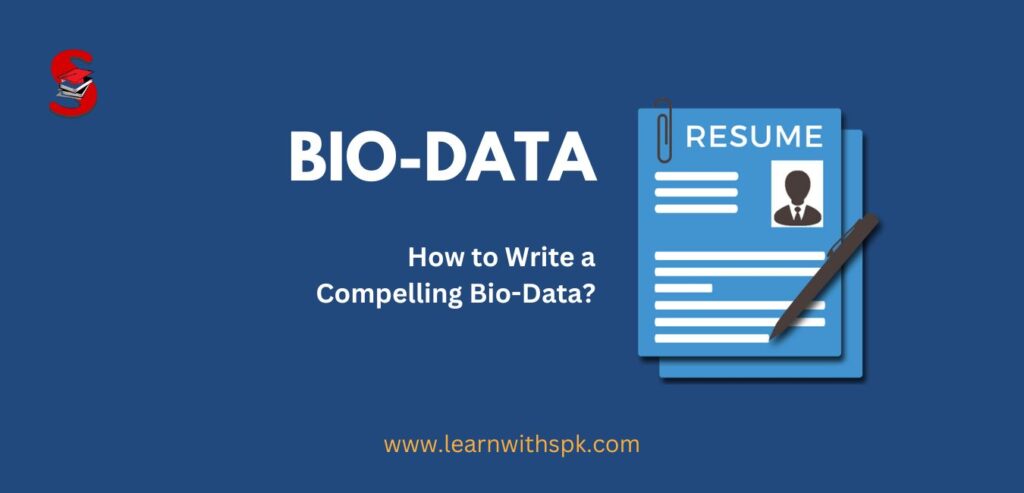Want to write a bio-data for a job? How to write a compelling bio-data? This article will lead you to a few important tips for writing an effective bio-data, how to utilize the keywords in a bio-data, how to effectively use the information of yourself in a bio-data etc.
Crafting a Attention Grabbing Bio-Data | Important Points to Remember
One of the most effective ways to introduce yourself and highlight your professional personality is by creating a compelling biodata. A strong bio-data may make a lasting impact on any kind of platform, be it a personal website, social network page, or application for a job. Understanding the important components of an engaging biodata and how to organize it effectively are crucial for achieving this.
The craft of crafting a powerful and captivating bio-data will be discussed in this article, along with helpful hints and examples to help you produce a bio-data that really shines. We will assist you in creating a biodata that makes an impression, from creating an engaging opening to emphasizing your special abilities and achievements.

Significance of Good Bio-data
In good English, a biodata is a sort of ‘curriculum vitae’ (C.V.). It is a brief account of one’s career. It may be either an academic career or a professional career. Thus, bio-data can be better discussed into two broad sub-heads. The first one is academic bio-data or fresher’s C.V. Another one is professional bio-data or C.V. of an experienced person in a particular field of activity.
It is very easy to prepare a fresher’s bio-data. But people do generally get puzzled in projecting themselves as super, dynamic, and result-oriented professional executive through their respective C.V.s.
It is customary to draw a ‘Silverline’ in preparing ‘attractive’ and ‘appealing’ bio-data in both cases. It will be sent to an unknown (something Known) reader and many have to compete with hundreds of other C.V.s. The fact that your C.V. will be one among many should not put you off but rather encourage you to plan and develop your C.V. so it will stand out from others.
Unless the Company or concerned authority to which you are applying specifically asks you to send C.V. in handwriting, it is better to prepare the bio-data in well-typed or DTP composed to ensure a better impression. Your handwriting cannot be as neat as it might be.
Always use good quality, preferably plain, white paper of standard business size. Write or type on one side of the paper.
In this fastest-changing market-led society higher authorities, who will verify and finalize your candidature, have very little time to look into the C.V. at length. So, it is suggested that your C.V. should be brief (a bird’s eye view) and to the point (relevant to the post being applied for). Unnecessarily, never kill your and your examiner’s invaluable time by preparing a long and uneconomic C.V. It will create a bad impression on you.
Thus, a C.V. or Resume is a documentary record of your education, qualifications, and employment history. It is the documents that get you in front of an employer. It’s the first stage of the selling process with the next stage being the interview or presentation.
Maximizing Impact: Tips for Writing an Attention-Grabbing Bio-Data
When applying for a job you are effectively trying to sell your skills to the employer. The employer will decide whether to interview you depending on the contents of your C.V. The C.V. is therefore not just a documentary record of your career to date but also a chance to sell yourself. Spending time getting your C.V. right is therefore well worth the effort involved. Ensure the information supplied is relevant to the role you are applying for.
Utilizing Keywords in Your Bio-Data
A person making a preliminary decision on your suitability for this role may not have in-depth knowledge of the position and may well discount you if there are no ‘keywords’ within your details that clearly illustrate your ability to fulfill the role. In addition, with a significant response to an advertising campaign, the candidate may well be short-listed electronically. The key is to ensure any experience you are supporting to offer is reflected in the details supplied. i.e. if you include within your summary: ‘experience of project management, delivery of budget, etc.’ you must ensure this is validated clearly in your roles and experience.
When you send your resume in, always accompany it with a cover letter; addressed to the person in charge of human resource matters for the department you are interested in joining. Call the company to ask for the name, address, contacts, and appointment of this person, to personalize your demonstrated sincerity.
How much information should a C.V. contain?
The resume or CV should be 2 to 4 pages in length. However, with modern search engines, it is imperative to add a separate page at the back with a list of keywords that convey your experience in totality. All ‘buzz’ words should be included. The list of words could well cover the whole page.
You can also read our post on How to Prepare for Job Interview?
What style should you use?
Write in the first person. It must be relevant. Give maximum coverage to the most relevant experience. Don’t leave gaps. Employers are suspicious of unexplained gaps in the timeline of a CV. If you took a year off to go traveling or were forced not to work because of other commitments then say so.